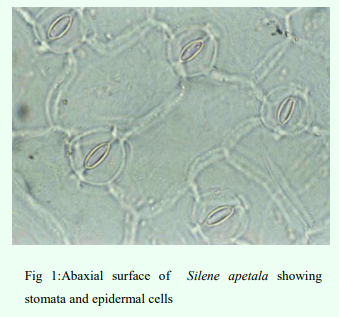
Leaf epidermal anatomy of the genus Silene (Caryophyllaceae) from Pakistan
Sahreen S., Khan M. A., Khan M. R., Kan R. A. (2010)
Sumaira SAHREEN 1, Mir Ajab KHAN 2, Muhammad Rashid KHAN 3, Rahmat Ali KHAN 3,
1 Botanical Sciences Division, Pakistan Museum of Natural History, Islamabad, Pakistan
2 Department of Plant Sciences, Quaid-i-Azam University, Islamabad, Pakistan
3 Department of Biochemistry, Quaid-i-Azam University, Islamabad, Pakistan
===
Biological Diversity and Conservation 3(1): 93-102 – ISSN 1308-5301 Print – ISSN 1308-8084 Online –
https://dergipark.org.tr/en/download/article-file/1192122
Abstract
Anatomical studies of 16 species of the genus Silene have been carried out from Pakistan by light microscopy. There is considerable variation in leaf epidermal anatomy in the species of Silene. In anatomical studies type of stomata, shape and size of epidermal cells, trichomes and crystals are important to identify the taxa at specific level. In almost all the species abaxial surface was different from the adaxial surfaces. . Diacytic type of stomata is the diagnostic character of family Caryophyllaceae. In Silene basic type of stomata is diacytic but some other stomatal types are also present such as anisocytic and anomocytic. S.arenosa can be easily distinguished by cristarque type of crystal. Epidermal cells of S. moorcroftiana are larger in size i.e.125 µm in length while in S. indica length of epidermal cell is 30µm. In S. villosa 4 – 5 – celled glandular hairs are abundantly present that is its species- specific character. The study suggests that the genus Silene has both primitive as well as advanced characters. A dichotomous key is constructed for the species
identification using the characters that have been studied.